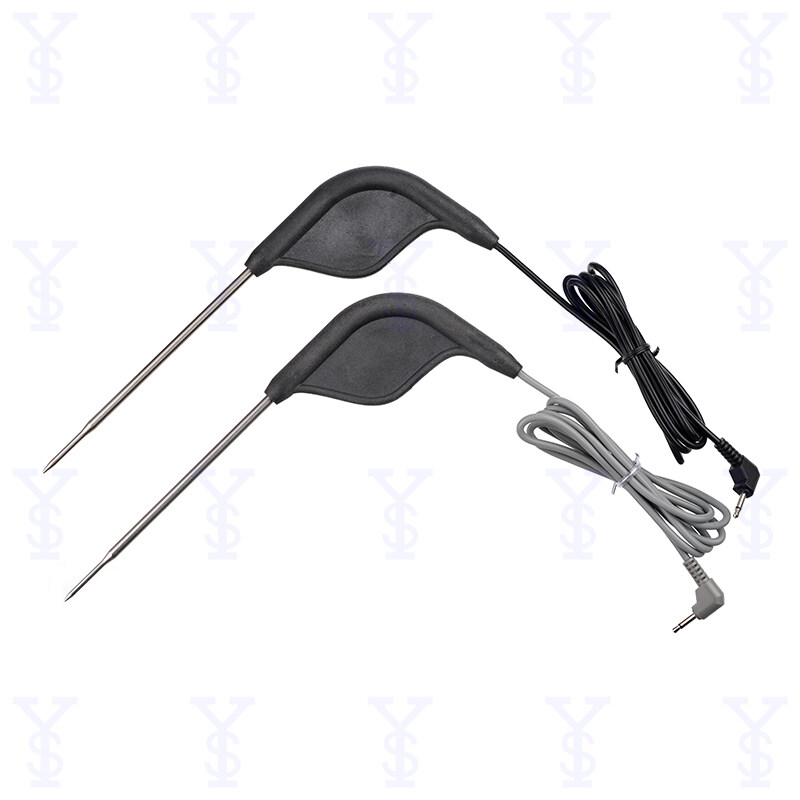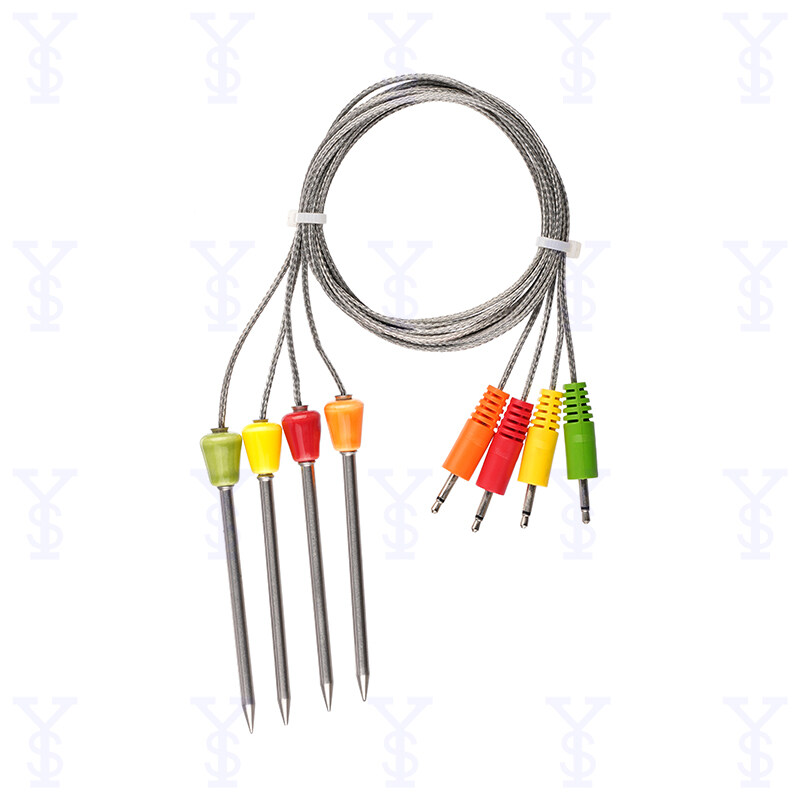E-mail-formatfejl
emailCannotEmpty
emailDoesExist
pwdLetterLimtTip
inconsistentPwd
pwdLetterLimtTip
inconsistentPwd


Enhancing Commercial Kitchen Efficiency with Commercial Food Temp Probes
In today's fast-paced culinary world, precision and consistency are key to success. Commercial food temp probes provide chefs and kitchen staff with the tools they need to ensure food safety, quality, and optimal cooking results. In this blog post, we'll explore the benefits of commercial food temp probes, how they work, and how they can streamline operations in commercial kitchens.
Chapter 1: The Importance of Temperature Control in Commercial Kitchens
The Critical Role of Temperature in Food Safety and Quality:
In a commercial kitchen, maintaining proper temperature control is paramount to ensuring food safety and quality. Improperly cooked or stored food can lead to foodborne illnesses, spoilage, and customer dissatisfaction. Temperature control is especially crucial when dealing with high-risk foods such as meat, poultry, seafood, and dairy products. Commercial food temp probes provide chefs and kitchen staff with the tools they need to monitor and maintain safe cooking and storage temperatures, minimizing the risk of foodborne illness outbreaks and ensuring that customers enjoy safe and delicious meals.
Challenges of Maintaining Consistent Temperatures in Commercial Kitchens:
Commercial kitchens face unique challenges when it comes to maintaining consistent temperatures. Factors such as the high volume of food production, frequent opening and closing of oven and refrigerator doors, and varying ambient temperatures can all affect the internal temperatures of food products. Additionally, commercial kitchens often have multiple cooking appliances operating simultaneously, each with its own temperature requirements. Without proper temperature monitoring and control, chefs risk overcooking or undercooking food, resulting in wasted ingredients and dissatisfied customers.
Introduction to Commercial Food Temp Probes: Ensuring Precision and Compliance:
The temp probes are specialized temperature monitoring devices designed for use in commercial kitchens. These probes consist of a sensor or probe that is inserted into the food product or cooking equipment, along with a digital display unit that provides real-time temperature readings. The temp probes are available in a variety of styles and configurations to suit different cooking applications, including oven probes, grill probes, refrigerator probes, and ambient temperature probes. By providing accurate and reliable temperature readings, these probes help chefs and kitchen staff maintain precise control over cooking processes, ensuring food safety, quality, and compliance with food safety regulations.
Chapter 2: Understanding Commercial Food Temp Probes
Exploring the Components and Features:
The temp probes typically consist of three main components: the sensor or probe, the cable, and the digital display unit. The sensor or probe is inserted into the food product or cooking equipment to measure its internal temperature. The cable connects the probe to the digital display unit, allowing chefs to monitor temperature readings from a distance. The digital display unit typically features a digital screen that displays temperature readings in real-time, as well as buttons or controls for setting temperature alarms and adjusting settings.
Types of Probes: Thermocouples, RTDs, and Thermistors:
The temp probes utilize different types of sensors to measure temperature, including thermocouples, resistance temperature detectors (RTDs), and thermistors. Thermocouples are composed of two different metal alloys that generate a voltage proportional to the temperature difference between the two junctions. RTDs are composed of a temperature-sensitive resistor material that changes resistance in response to temperature changes. Thermistors are composed of a temperature-sensitive semiconductor material that changes resistance with temperature. Each type of sensor has its own advantages and disadvantages in terms of accuracy, response time, and temperature range.
Wireless vs. Wired Probes: Pros and Cons:
The food temp probes are available in both wireless and wired configurations. Wireless probes use radio frequency (RF) or Bluetooth technology to transmit temperature readings to a remote receiver or mobile device, allowing chefs to monitor temperatures from a distance. Wired probes, on the other hand, are connected directly to the digital display unit via a cable. While wireless probes offer greater flexibility and convenience, they may be susceptible to interference or signal dropout, especially in busy commercial kitchen environments. Wired probes, on the other hand, provide a more reliable connection but may be less convenient to use.
Calibration and Accuracy: Ensuring Reliable Temperature Readings:
Calibration is a critical aspect of ensuring the accuracy and reliability. Over time, probes may drift out of calibration due to factors such as temperature fluctuations, mechanical shock, or exposure to moisture. Regular calibration helps to ensure that probes provide accurate temperature readings, allowing chefs to maintain precise control over cooking processes. Calibration procedures vary depending on the type of probe and manufacturer specifications but typically involve comparing the probe's readings to those of a known reference thermometer and making any necessary adjustments.
Chapter 3: Benefits of Using Commercial Food Temp Probes
Ensuring Food Safety Compliance: Monitoring Critical Control Points (CCPs):
In commercial kitchens, temperature monitoring is essential for compliance with food safety regulations and HACCP (Hazard Analysis and Critical Control Points) principles. The temp probes help chefs and kitchen staff monitor critical control points (CCPs) throughout the food production process, including cooking, cooling, hot holding, and cold holding. By ensuring that food products reach and maintain safe temperatures, chefs can reduce the risk of foodborne illness outbreaks and comply with regulatory requirements.
Consistency and Quality Assurance: Achieving Uniform Cooking Results:
Consistency is key to success in the restaurant industry, and the temp probes play a crucial role in achieving consistent cooking results. By providing accurate and reliable temperature readings, probes help chefs ensure that food products are cooked to the desired level of doneness every time. Whether grilling steaks, roasting poultry, or baking pastries, chefs can rely on temp probes to monitor internal temperatures and achieve uniform cooking results, resulting in satisfied customers and repeat business.
Time and Labor Savings: Streamlining Monitoring Processes:
In a busy commercial kitchen, time is of the essence, and chefs need tools that help them work efficiently. The temp probes streamline temperature monitoring processes, allowing chefs to monitor multiple cooking processes simultaneously and without constant supervision. Wireless probes, in particular, offer chefs the flexibility to monitor temperatures from a distance, freeing up time for other tasks such as food preparation, plating, and customer service. By reducing the need for manual temperature checks, probes help chefs work more efficiently and effectively, saving time and labor costs.
Reducing Food Waste: Preventing Overcooked or Undercooked Dishes:
Overcooked or undercooked dishes can result in wasted ingredients, increased food costs, and dissatisfied customers. The temp probes help chefs prevent food waste by ensuring that food products are cooked to the correct internal temperature every time. By monitoring internal temperatures in real-time, chefs can avoid overcooking or undercooking food, resulting in perfectly cooked dishes that are safe to eat and meet customer expectations. By reducing the number of rejected or discarded dishes, probes help restaurants save money and improve profitability.
Chapter 4: Applications of Commercial Food Temp Probes in Commercial Kitchens
Monitoring Cooking Temperatures: Grilling, Roasting, and Frying:
The temp probes are commonly used to monitor cooking temperatures in a variety of applications, including grilling, roasting, and frying. When grilling steaks or burgers, probes can be inserted into the thickest part of the meat to monitor internal temperatures and ensure that they reach the desired level of doneness. Similarly, when roasting poultry or pork, probes can be used to monitor internal temperatures and prevent overcooking or undercooking. In deep-frying applications, probes can be used to monitor oil temperatures and ensure that they remain within the optimal range for frying.
Sous Vide Cooking: Precise Temperature Control for Perfectly Cooked Results:
Sous vide cooking has become increasingly popular in commercial kitchens due to its ability to produce perfectly cooked dishes with precise temperature control. The temp probes are essential tools for sous vide cooking, allowing chefs to monitor water bath temperatures and ensure that food products are cooked to the desired level of doneness. By maintaining precise temperature control throughout the cooking process, chefs can achieve consistent results every time, resulting in tender, flavorful dishes that are cooked to perfection.
Holding and Serving Temperatures: Buffets, Banquets, and Catering Events:
In buffet, banquet, and catering settings, maintaining proper holding and serving temperatures is essential for food safety and quality. The temp probes help chefs monitor holding and serving temperatures to ensure that food products remain safe and appetizing for extended periods. Whether holding hot dishes in warming trays or cold dishes on ice beds, probes allow chefs to monitor temperatures and make adjustments as needed to prevent foodborne illness outbreaks and ensure customer satisfaction.
Refrigeration and Freezer Monitoring: Preventing Food Spoilage:
Proper refrigeration and freezer temperatures are critical for preventing food spoilage and maintaining food quality in commercial kitchens. The temp probes are used to monitor refrigeration and freezer temperatures to ensure that they remain within the optimal range for food storage. By regularly monitoring temperatures and responding promptly to any deviations, chefs can prevent food spoilage, extend the shelf life of perishable ingredients, and reduce food waste.
Chapter 5: Choosing the Right Commercial Food Temp Probes
Factors to Consider When Selecting Commercial Food Temp Probes:
When selecting the temp probes for your kitchen, there are several factors to consider to ensure that you choose the right probes for your needs:
- Temperature Range: Choose probes that can accurately measure temperatures within the range required for your cooking applications.
- Accuracy: Look for probes that provide accurate temperature readings with minimal deviation.
- Response Time: Consider the response time of the probes, especially in fast-paced cooking environments where rapid temperature changes occur.
- Durability: Choose probes with durable construction and materials that can withstand the rigors of commercial kitchen use.
- Ease of Use: Opt for probes with user-friendly features and intuitive controls that are easy for kitchen staff to operate.
Durability and Reliability: Built for the Rigors of Commercial Kitchen Use:
The temp probes are designed to withstand the demanding conditions of commercial kitchen environments. These probes are constructed from durable materials such as stainless steel, aluminum, and heat-resistant plastics that can withstand high temperatures, mechanical shock, and exposure to moisture and chemicals. Additionally, commercial probes undergo rigorous testing and certification to ensure that they meet industry standards for accuracy, reliability, and safety. By investing in high-quality probes built for commercial use, chefs can trust that their equipment will perform reliably and consistently in even the busiest kitchen environments.
Ease of Use and Maintenance: Intuitive Design and Cleaning Procedures:
In a fast-paced commercial kitchen, simplicity and efficiency are key when it comes to equipment operation and maintenance. The temp probes are designed with user-friendly features and intuitive controls that make them easy for kitchen staff to operate, even during busy service periods. Additionally, probes are designed with removable or waterproof components that make them easy to clean and sanitize between uses. Regular cleaning and maintenance help prolong the lifespan of probes and ensure accurate temperature readings, reducing the risk of equipment malfunction and downtime.
Integration with Kitchen Equipment and Systems: Compatibility and Connectivity Options:
The temp probes are designed to integrate seamlessly with a variety of kitchen equipment and systems, including ovens, grills, fryers, refrigerators, and sous vide machines. Probes may feature compatibility with industry-standard connectors and interfaces, allowing them to be easily connected to existing kitchen equipment without the need for additional adapters or modifications. Additionally, some probes offer wireless connectivity options, allowing chefs to monitor temperatures remotely from a mobile device or computer. By choosing probes that are compatible with existing equipment and systems, chefs can streamline temperature monitoring processes and improve kitchen efficiency.
Chapter 6: Proper Use and Care of Commercial Food Temp Probes
Correct Probe Placement: Ensuring Accurate Temperature Readings:
Proper probe placement is essential for obtaining accurate temperature readings and ensuring food safety and quality. When using the food temp probes, chefs should follow manufacturer guidelines for probe placement based on the type of food being cooked and the cooking method being used. In general, probes should be inserted into the thickest part of the food product, away from bones, fat deposits, or other heat sources that may affect temperature readings. Additionally, chefs should ensure that probes are securely inserted and that cables are properly routed to prevent interference or damage during cooking.
Cleaning and Sanitization Procedures: Preventing Cross-Contamination:
Regular cleaning and sanitization are essential for preventing cross-contamination and ensuring food safety in commercial kitchens. The temp probes should be cleaned and sanitized between each use to remove food residue, grease, and bacteria that may be present on the probe surface. Depending on the type of probe and manufacturer recommendations, probes may be cleaned using warm, soapy water, commercial cleaning solutions, or disinfectant wipes. Additionally, probes should be sanitized using heat, chemical sanitizers, or UV light to kill any remaining bacteria and ensure that they are safe for use in food preparation.
Regular Calibration and Maintenance: Maximizing Accuracy and Lifespan:
Regular calibration and maintenance are critical for ensuring the accuracy and reliability of the temp probes. Over time, probes may drift out of calibration due to factors such as temperature fluctuations, mechanical shock, or exposure to moisture. Chefs should calibrate probes according to manufacturer recommendations using a known reference thermometer and make any necessary adjustments to ensure that they provide accurate temperature readings. Additionally, probes should be inspected regularly for signs of damage or wear, such as frayed cables, bent probes, or cracked housings, and replaced as needed to maintain accuracy and performance.
Chapter 7: Case Studies: Real-World Examples of Commercial Food Temp Probe Success
Restaurant Chains: Ensuring Consistency Across Multiple Locations:
Restaurant chains rely on the temp probes to maintain consistency and quality across multiple locations. By using probes to monitor cooking temperatures and ensure uniform cooking results, chains can deliver consistent dining experiences to customers regardless of location. Probes also help chains comply with food safety regulations and maintain brand standards for food quality and safety.
Hotels and Resorts: Meeting High Volume Demands with Precision:
Hotels and resorts face unique challenges when it comes to meeting high volume demands while maintaining food quality and safety standards. The temp probes help hotels and resorts streamline kitchen operations by providing chefs with real-time temperature monitoring and control. Probes allow chefs to cook large quantities of food with precision, ensuring that dishes are cooked to the correct temperature and quality standards every time.
Catering Companies: Delivering Safe and Delicious Meals Onsite:
Catering companies rely on commercial food temp probes to ensure that meals are safely prepared and served onsite at events and functions. Probes allow chefs to monitor cooking, holding, and serving temperatures to prevent foodborne illness outbreaks and ensure customer satisfaction. By using probes to maintain precise temperature control, catering companies can deliver safe and delicious meals that meet the needs and preferences of their clients.
Institutional Kitchens: Providing Nutritious Meals to Schools and Hospitals:
Institutional kitchens such as school cafeterias and hospital kitchens play a vital role in providing nutritious meals to students, patients, and staff. Commercial food temp probes help institutional kitchens maintain food safety and quality standards by monitoring cooking and holding temperatures. Probes allow kitchen staff to ensure that meals are cooked to the correct temperature and served at safe holding temperatures, reducing the risk of foodborne illness outbreaks and ensuring the well-being of patrons.
Chapter 8: Troubleshooting Common Issues with Commercial Food Temp Probes
Inaccurate Readings: Calibration and Adjustment Tips:
If a temp probe is providing inaccurate temperature readings, chefs should first attempt to recalibrate the probe according to manufacturer recommendations. This may involve comparing the probe's readings to those of a known reference thermometer and making any necessary adjustments. If recalibration does not resolve the issue, chefs should inspect the probe and cable for signs of damage or wear, such as frayed cables, bent probes, or cracked housings, and replace any damaged components as needed.
Probe Damage: Replacement and Repair Procedures:
The temp probes are subjected to harsh conditions in commercial kitchen environments and may become damaged or worn over time. If a probe is damaged or malfunctioning, chefs should follow manufacturer recommendations for replacement or repair. This may involve ordering replacement parts or contacting the manufacturer for warranty service. Chefs should also inspect probes regularly for signs of damage or wear and replace any damaged components promptly to ensure accurate temperature readings and safe food preparation.
Connectivity Issues: Troubleshooting Wireless and Wired Probes:
If a temp probe is experiencing connectivity issues, chefs should first check the batteries or power source to ensure that they are properly inserted or charged. For wireless probes, chefs should also ensure that the probe and receiver are within range and that there are no obstructions or interference sources that may disrupt the signal. If connectivity issues persist, chefs may need to reset or re-sync the probe and receiver according to manufacturer instructions, or contact technical support for troubleshooting assistance.
Chapter 9: Tips for Maximizing Efficiency with Commercial Food Temp Probes
Staff Training and Education: Ensuring Proper Use and Understanding:
Proper staff training and education are essential for maximizing the efficiency and effectiveness in a commercial kitchen. Chefs and kitchen staff should receive comprehensive training on how to use probes correctly, including proper probe placement, calibration procedures, and cleaning and maintenance protocols. Additionally, staff should understand the importance of temperature control in food safety and quality and be able to recognize and respond to temperature-related issues in real-time.
Utilizing Data and Analytics: Optimizing Cooking Processes and Menu Development:
Commercial food temp probes generate valuable data that can be used to optimize cooking processes and inform menu development decisions. Chefs can use temperature data to identify trends and patterns in cooking times and temperatures, allowing them to adjust cooking processes and recipes for better results. Additionally, temperature data can be used to track food safety compliance and identify areas for improvement in kitchen operations. By leveraging data and analytics, chefs can optimize cooking processes, reduce waste, and enhance overall kitchen efficiency and performance.
Investing in Quality Equipment: Choosing Probes Built for Performance and Reliability:
When it comes to commercial food temp probes, quality matters. Chefs should invest in high-quality probes built for performance and reliability to ensure accurate temperature readings and long-term durability. Chefs should look for probes from reputable manufacturers with a track record of producing reliable equipment for commercial kitchen use. Additionally, chefs should consider factors such as temperature range, accuracy, response time, and durability when selecting probes to ensure that they meet the specific needs and requirements of their kitchen operations.
Conclusion: Transforming Commercial Kitchen Operations with Commercial Food Temp Probes
Congratulations! You've now unlocked the potential of commercial food temp probes to revolutionize efficiency, consistency, and safety in commercial kitchens. By understanding the importance of temperature control, selecting the right probes for your needs, and implementing best practices for their use and maintenance, you're well on your way to achieving culinary excellence and satisfying your customers' appetites. So go ahead, equip your kitchen with the latest in temperature monitoring technology, and elevate your operations to new heights. Happy cooking!

